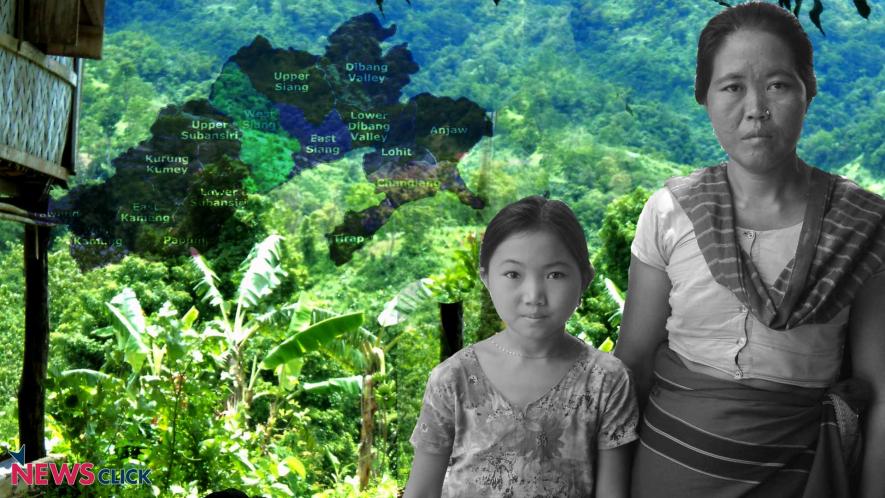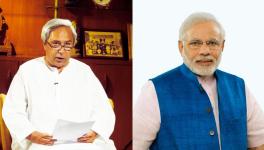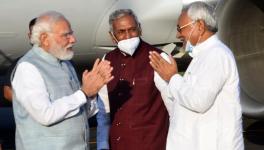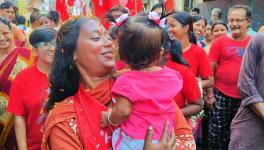Limited Citizenship to Chakma and Hajong Refugees Show Double Standard of the Indian Government

Newsclick Image by Trina Shankar
Amidst the row over Rohingya refugees and their deportation, the Central government is all set to grant limited citizenship to Chakma and Hajong refugees who have been living in India for more than five decades now. Union ministry officials said the communities would not have any right to land ownership or tribal rights which may trigger conflict in the region.
During the last week, following Supreme Court’s order to grant citizenship to 54,000 Chakma and Hajong, the Centre took the decision in a meeting chaired by Union Home Minister Rajnath Singh. The meeting was attended by National Security Advisor Ajit Doval, Minister of State for Home Kiren Rijiju and Arunachal Pradesh Chief Minister Pema Khandu.
Centre’s decision to grant citizenship for Chakma and Hajong, who are Hindus and Buddhists respectively, came days after India has faced criticisms from United Nations Human Rights Commissioner Zeid Ra’ad Al Hussein for its plan to deport Rohingya Muslims to Myanmar.
Earlier, Centre had stated that New Delhi would deport the 40,000 Rohingya Muslims currently residing in India back to Myanmar, where the community is facing violence, amid concerns of terror threats.
Is India treating the refugees on the basis of religious grounds?
Centre’s move to grant citizenship for Chakmas and Hajongs came as an aftermath of Citizenship (Amendment) Bill 2016 which “makes illegal migrants who are Hindus, Sikhs, Buddhists, Jains, Parsis and Christians from Afghanistan, Bangladesh and Pakistan, eligible for citizenship.” It clearly indicates BJP’s policy to give citizenship to non-Muslim refugees only. It is clear case of double standard on part of the Indian Government. Everyone else has right to citizenship in the country except Muslims, is the message the government is trying to give.
According to Chakma Autonomous District Council Data, the present population of the Chakmas is about 80,000 – 100,000 in Mizoram, 60-70 thousand in Arunachal Pradesh, 40-50 thousand in Tripura, about 30 thousand in Assam and few families in West Bengal. Another set of data shows that more than 1.5 lakh of Hajongs live in India.
Protests in Arunachal Pradesh
Protests have emerged in the northeastern states especially in Arunachal Pradesh where most of the Chakma and Hajong live.
"We are trying to tell the Supreme Court that giving Chakmas and Hajongs the same rights is not acceptable to us," said Kiren Rijiju.
Opposing the Centre’s decision, Arunachal Pradesh Chief Minister has stated that such move would change the demographics of the state which has a predominantly tribal population with special rights including over land.
"The Chakma and Hajong have been hanging around for decades without any rights, so there is definitely a need to give them sort of citizenship," said Walter Fernandes, a senior fellow at the North Eastern Social Research Centre in Guwahati.
"But giving tens of thousands, rights in the small northeastern states can be a problem. Jobs are not plentiful, the land is scarce, and it can shift the balance of power in small constituencies," he added.
Countering the arguments over the concerns about stealing jobs and land, Paritosh Chakma, secretary general of the All India Chakma Social Forum lobby group, said it is not valid.
"We are also a tribal people, we have lived here a long time, and our traditions and customs are the same. Citizenship is our legal right, and we must get all the rights that an Indian citizen has, including over land," Paritosh added.
Why does Arunachal Pradesh worry about the citizenship of Chakmas and Hajongs?
The history and migration of these communities give us an idea about why the state confronts Chakmas and Hajongs.
Chakmas and Hajongs of Northeast India were originally inhabitants of Chittagong Hills of Bangladesh. In 1961, they were first displaced from their land because of the Kaptai Dam. The dam which was commissioned in 1962 caused the submergence of 22,000 hectares of cultivable land. Environmental researchers pointed out that 1, 00,000 tribal people, 70% of them Chakmas, were displaced by the lake which was created by the dam. Later, they crossed the border as the victims of religious persecution in Bangladesh.
Fearing conflicts between Chakmas, who crossed over the Lushai Hills District of Assam (now in Mizoram), and Mizos, Assam government had sent Chakmas to Tirap Division of North East Frontier Agency (NEFA). According to reports, 14,888 persons were settled, mainly in the Tirap, Lohit and Subansiri districts of NEFA, from 1964-69.
In 1972, the Indian government decided to grant citizenship for the Chakmas who were residing in the NEFA region. Arunachal Pradesh came into existence in the same year as a union territory opposed Centre’s decision. The All Arunachal Pradesh Students Union (AAPSU) had organized strong movements against the settling of Chakmas and Hajongs by the time 1987 when the state had attained complete statehood.
In his book “States in South Asia: The Chakmas between Bangladesh and India” Deepak K Singh explains how the AAPSU has grown stronger over the period of time as the resistance against Chakmas.
Disclaimer: The views expressed here are the author's personal views, and do not necessarily represent the views of Newsclick.
Get the latest reports & analysis with people's perspective on Protests, movements & deep analytical videos, discussions of the current affairs in your Telegram app. Subscribe to NewsClick's Telegram channel & get Real-Time updates on stories, as they get published on our website.
























